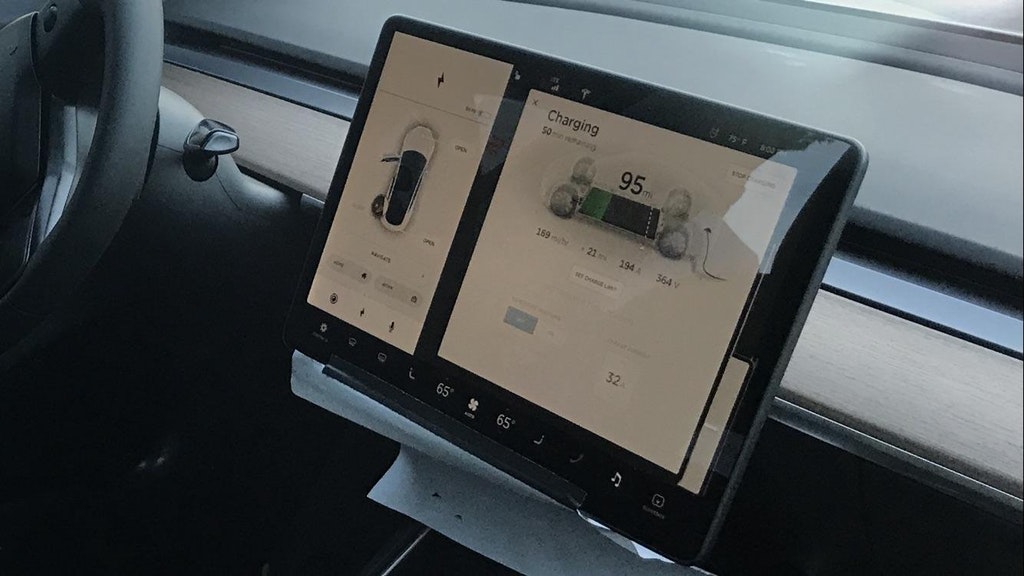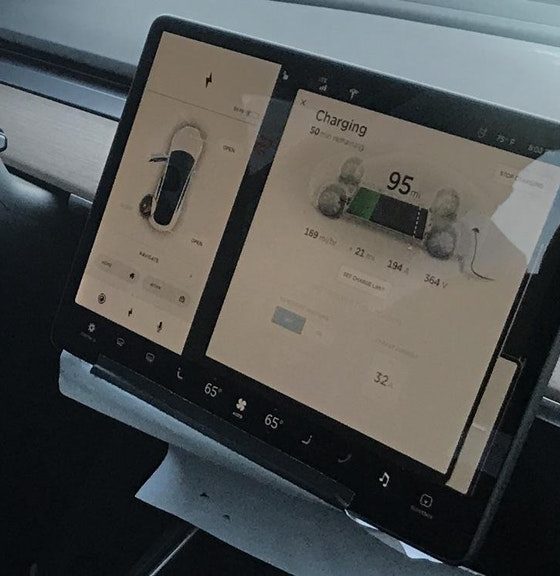

News
Dissecting Tesla Model 3’s 2170 lithium ion battery cell, what’s inside?
A teardown video featuring Tesla Model 3’s 2170 lithium-ion battery cell was recently uploaded on YouTube, showing the components of the cylindrical cell and how it stacks up against the Model S and Model X’s 18650 battery cell.
Aries RC, a channel dedicated to battery improvements in the remote control aircraft market, indicated that they acquired a 2170 lithium-ion cell from Tesla’s Gigafactory in Nevada. The host noted that the first thing he did was to connect the battery to a resistor, in order to completely drain the cell. Next, he made a cut at the positive terminal of the battery unit to expose a plastic dielectric barrier on the cell. This barrier is utilized by Tesla as a means to prevent the jelly roll inside from physically touching the top of the battery, which would cause a short circuit. As noted by the YouTube channel’s host, the negative terminal of the 2170 lithium-ion cell also features a similar dielectric barrier.
The Model 3’s 2170 cell features a thin layer of insulation on its interior, which, according to the RC enthusiast, is an outer layer of material that protects the cell wall’s integrity during a thermal runaway. In instances when the lithium-ion cell does heat up, however, Tesla has implemented a safety system in the form of three small cooling holes at the top of the battery. These small holes are about 0.5 mm wide, and are designed to vent out gases when the cell reaches high temperatures.
The jelly roll of the 2170 battery is wrapped in a copper sheet, which acts as a ground for the battery. A grounding strip is also attached to the copper strip using tap welding, which, according to the YouTube channel’s host, is particularly impressive, since tap welding is notoriously difficult to accomplish on thin pieces of metal.
The jelly roll of the Model 3’s battery cell features a lithium-nickel-cobalt-aluminum oxide that’s responsible for storing energy in the battery. Fully unrolled, the strip fitted with the compound measured roughly 32 inches long, roughly a third longer than the strip in Tesla’s 18650 battery, which is roughly 24 inches long.
RELATED: Watch this Tesla Model S battery teardown performed by veteran EV modders
As could be seen in a side-by-side comparison of the jelly rolls of the 2170 and 18650 cells, Tesla’s newest form factor 2170 cell features a roll that is significantly longer and thicker than the latter. Overall, the YouTube host suggested that Tesla seems to be accurate in its estimates that the 2170 cell carries roughly 30 percent more charge than the 18650 lithium-ion cell in the Model S and X.
Tesla uses thousands of 2170 cells to enable its mass market Long Range Model 3 to travel up to 310 miles on a single charge. Produced in partnership with Panasonic at the Nevada Gigafactory, Tesla’s 2170 lithium-ion battery modules proved to be one of the sources of the Model 3’s production bottlenecks last year. As revealed by recent building permits, however, Tesla is currently conducting large-scale improvements to the Gigafactory, aimed at automating its battery module production line.
Apart from the Model 3, Tesla also uses its 2170 lithium-ion cell for its Powerpack and Powerwall battery solutions. As confirmed by Tesla CEO Elon Musk through Twitter, however, the 2170 cells will not be making their way to the Model S and X, at least as of writing.

News
Tesla FSD fleet is nearing 7 billion total miles, including 2.5 billion city miles
As can be seen on Tesla’s official FSD webpage, vehicles equipped with the system have now navigated over 6.99 billion miles.

Tesla’s Full Self-Driving (Supervised) fleet is closing in on almost 7 billion total miles driven, as per data posted by the company on its official FSD webpage.
These figures hint at the massive scale of data fueling Tesla’s rapid FSD improvements, which have been quite notable as of late.
FSD mileage milestones
As can be seen on Tesla’s official FSD webpage, vehicles equipped with the system have now navigated over 6.99 billion miles. Tesla owner and avid FSD tester Whole Mars Catalog also shared a screenshot indicating that from the nearly 7 billion miles traveled by the FSD fleet, more than 2.5 billion miles were driven inside cities.
City miles are particularly valuable for complex urban scenarios like unprotected turns, pedestrian interactions, and traffic lights. This is also the difference-maker for FSD, as only complex solutions, such as Waymo’s self-driving taxis, operate similarly on inner-city streets. And even then, incidents such as the San Francisco blackouts have proven challenging for sensor-rich vehicles like Waymos.
Tesla’s data edge
Tesla has a number of advantages in the autonomous vehicle sector, one of which is the size of its fleet and the number of vehicles training FSD on real-world roads. Tesla’s nearly 7 billion FSD miles then allow the company to roll out updates that make its vehicles behave like they are being driven by experienced drivers, even if they are operating on their own.
So notable are Tesla’s improvements to FSD that NVIDIA Director of Robotics Jim Fan, after experiencing FSD v14, noted that the system is the first AI that passes what he described as a “Physical Turing Test.”
“Despite knowing exactly how robot learning works, I still find it magical watching the steering wheel turn by itself. First it feels surreal, next it becomes routine. Then, like the smartphone, taking it away actively hurts. This is how humanity gets rewired and glued to god-like technologies,” Fan wrote in a post on X.
News
Tesla starts showing how FSD will change lives in Europe
Local officials tested the system on narrow country roads and were impressed by FSD’s smooth, human-like driving, with some calling the service a game-changer for everyday life in areas that are far from urban centers.

Tesla has launched Europe’s first public shuttle service using Full Self-Driving (Supervised) in the rural Eifelkreis Bitburg-Prüm region of Germany, demonstrating how the technology can restore independence and mobility for people who struggle with limited transport options.
Local officials tested the system on narrow country roads and were impressed by FSD’s smooth, human-like driving, with some calling the service a game-changer for everyday life in areas that are far from urban centers.
Officials see real impact on rural residents
Arzfeld Mayor Johannes Kuhl and District Administrator Andreas Kruppert personally tested the Tesla shuttle service. This allowed them to see just how well FSD navigated winding lanes and rural roads confidently. Kruppert said, “Autonomous driving sounds like science fiction to many, but we simply see here that it works totally well in rural regions too.” Kuhl, for his part, also noted that FSD “feels like a very experienced driver.”
The pilot complements the area’s “Citizen Bus” program, which provides on-demand rides for elderly residents who can no longer drive themselves. Tesla Europe shared a video of a demonstration of the service, highlighting how FSD gives people their freedom back, even in places where public transport is not as prevalent.
What the Ministry for Economic Affairs and Transport says
Rhineland-Palatinate’s Minister Daniela Schmitt supported the project, praising the collaboration that made this “first of its kind in Europe” possible. As per the ministry, the rural rollout for the service shows FSD’s potential beyond major cities, and it delivers tangible benefits like grocery runs, doctor visits, and social connections for isolated residents.
“Reliable and flexible mobility is especially vital in rural areas. With the launch of a shuttle service using self-driving vehicles (FSD supervised) by Tesla in the Eifelkreis Bitburg-Prüm, an innovative pilot project is now getting underway that complements local community bus services. It is the first project of its kind in Europe.
“The result is a real gain for rural mobility: greater accessibility, more flexibility and tangible benefits for everyday life. A strong signal for innovation, cooperation and future-oriented mobility beyond urban centers,” the ministry wrote in a LinkedIn post.
News
Tesla China quietly posts Robotaxi-related job listing
Tesla China is currently seeking a Low Voltage Electrical Engineer to work on circuit board design for the company’s autonomous vehicles.

Tesla has posted a new job listing in Shanghai explicitly tied to its Robotaxi program, fueling speculation that the company is preparing to launch its dedicated autonomous ride-hailing service in China.
As noted in the listing, Tesla China is currently seeking a Low Voltage Electrical Engineer to work on circuit board design for the company’s autonomous vehicles.
Robotaxi-specific role
The listing, which was shared on social media platform X by industry watcher @tslaming, suggested that Tesla China is looking to fill the role urgently. The job listing itself specifically mentions that the person hired for the role will be working on the Low Voltage Hardware team, which would design the circuit boards that would serve as the nervous system of the Robotaxi.
Key tasks for the role, as indicated in the job listing, include collaboration with PCB layout, firmware, mechanical, program management, and validation teams, among other responsibilities. The role is based in Shanghai.
China Robotaxi launch
China represents a massive potential market for robotaxis, with its dense urban centers and supportive policies in select cities. Tesla has limited permission to roll out FSD in the country, though despite this, its vehicles have been hailed as among the best in the market when it comes to autonomous features. So far, at least, it appears that China supports Tesla’s FSD and Robotaxi rollout.
This was hinted at in November, when Tesla brought the Cybercab to the 8th China International Import Expo (CIIE) in Shanghai, marking the first time that the autonomous two-seater was brought to the Asia-Pacific region. The vehicle, despite not having a release date in China, received a significant amount of interest among the event’s attendees.








